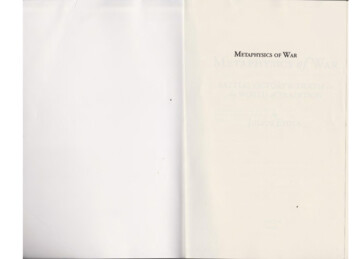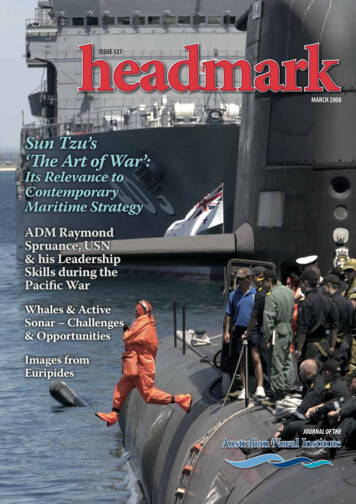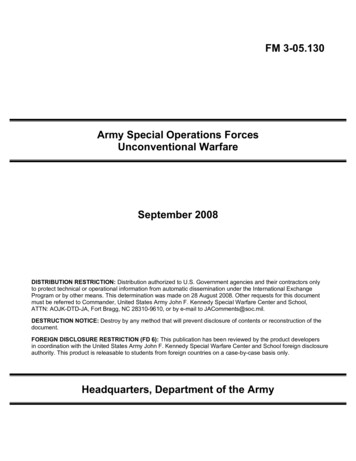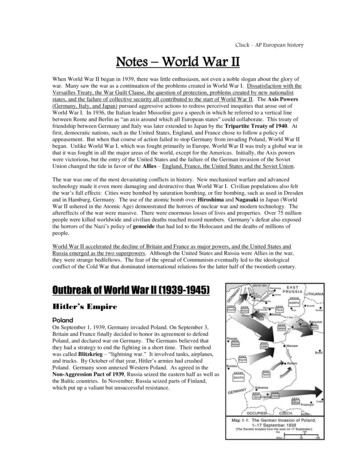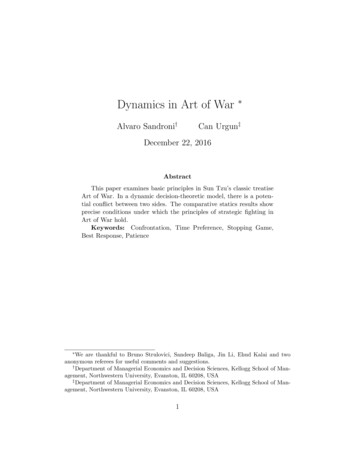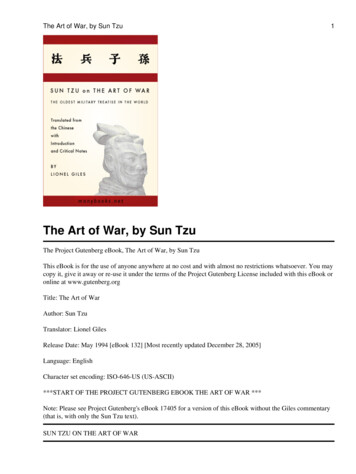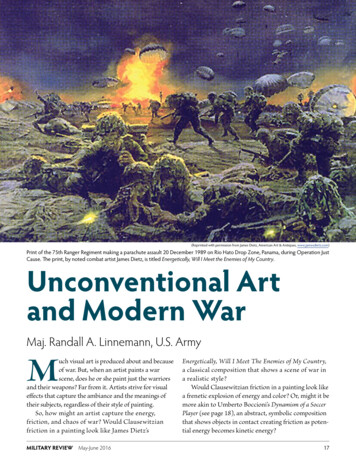
Transcription
UNCONVENTIONAL ART(Reprinted with permission from James Dietz, American Art & Antiques, www.jamesdietz.com)Print of the 75th Ranger Regiment making a parachute assault 20 December 1989 on Rio Hato Drop Zone, Panama, during Operation JustCause. The print, by noted combat artist James Dietz, is titled Energetically, Will I Meet the Enemies of My Country.Unconventional Artand Modern WarMaj. Randall A. Linnemann, U.S. ArmyMuch visual art is produced about and becauseof war. But, when an artist paints a warscene, does he or she paint just the warriorsand their weapons? Far from it. Artists strive for visualeffects that capture the ambiance and the meanings oftheir subjects, regardless of their style of painting.So, how might an artist capture the energy,friction, and chaos of war? Would Clausewitzianfriction in a painting look like James Dietz’sMILITARY REVIEWMay-June 2016Energetically, Will I Meet The Enemies of My Country,a classical composition that shows a scene of war ina realistic style?Would Clausewitzian friction in a painting look likea frenetic explosion of energy and color? Or, might it bemore akin to Umberto Boccioni’s Dynamism of a SoccerPlayer (see page 18), an abstract, symbolic compositionthat shows objects in contact creating friction as potential energy becomes kinetic energy?17
If the energy, the friction, and the chaos of warwere illustrated in the latterstyle, if kinetic energy werea frenetic explosion ofcolors and angles, then howwould potential energy bepainted? Would it be illustrated through the absenceof colors and objects, orwould it look like somethingelse? How would an artist’scultural perspective influence ways of representingpotential energy in a sceneof war, or potential energyin any kind of scene? Howmight understanding cultural perspectives in art revealtheir influence in ways ofconducting warfare?The West PaintsLike It Fights(Image courtesy of Wikimedia Commons)The precepts of design invisual art and the art of waroverlap. For example, the military concept of a centerof gravity relates to the artistic concept of emphasis.1 Ifa center of gravity is “the hub of all power and movement,” then a visual artwork’s center of gravity, or focalpoint, is the subject matter receiving emphasis.2 For instance, in Leonardo da Vinci’s Mona Lisa (see page 19),the subject’s smile is the most important aspect of thecomposition—the smile is the work’s center of gravity.In Rembrandt’s The Return of the Prodigal Son (seepage 20), the son’s head in his father’s chest is the centerof gravity. All faces and gazes point to a single hub in thecomposition, a hub that gives the composition power.Without the smile or the paternal embrace, neither theMona Lisa nor the Prodigal Son would emphasize anysubject. The very concept of emphasis, that one aspectof a picture is more important than all others, reinforcesthe idea that a picture can have a center of gravity.As gravity is a force exerted on objects to pullthem in a certain direction, the weights of objectshave certain relationships to the center of gravity, and the center of gravity helps determine theirDynamism of a Soccer Player (1913), oil on canvas, by Umberto Boccioni.18relationships to each other. Objects in visual arthave a visual weight, and the weight of the objectsshould balance each other, symmetrically or asymmetrically.3 While some may think of asymmetryas the absence of balance, in fact it encompassesall methods of balance that are not symmetrical.The Mona Lisa is symmetrically balanced. Her faceand her stance balance in the composition so thatnothing is disproportional. In contrast, Vincent vanGogh’s The Starry Night (see page 21), demonstratesasymmetrical balance. On the left, it shows severalstars and a prominent cypress tree. These are offsetby the disproportionately large moon and the townon the right. Similarly, defense strategists refer tosymmetry and asymmetry to describe how enemiescounter each other.The West Fights Like It PaintsU.S. Army Lt. Gen. H.R. McMaster quippedabout the Iraqi army in the First Gulf War, “thereare two ways to fight the United States military:May-June 2016MILITARY REVIEW
UNCONVENTIONAL ARTasymmetrically and stupid.”4 While the implication ofthis statement is that no military should ever engagethe U.S. military in a balanced, conventional fight, theU.S. military always has organized its staffing, equipping, and doctrine around a symmetric threat. U.S.military forces conduct what historianRussell F. Weigley dubbed in 1973“the American way of war,” based on“a strategy of attrition.”5 Although itevolved into what Max Boot would describe in 2003 as “a new American wayof war,” U.S. forces, nonetheless, stillorganize around a symmetric threat.6The American way of war now emphasizes technological overmatch, overwhelming precision firepower, and theoffense. This understanding treats waras a narrow and specific activity of violence in isolation from other elementsof national power.7Returning to McMaster’s belief thatno rational actor, of a nation-state orany other group, would go toe-to-toewith the U.S. military, asymmetricwarfare suggests that weaker adversaries will counter the United States’power by excelling in areas where theUnited States performs weakly. Inmany instances, adversaries seek toexploit U.S. reluctance to deviate fromrelying on technological overmatch,overwhelming firepower, and theoffense—which the United States considers its strengths in conventional war.Though disavowed by the PLA after an international uproar, unconventional ways of war such asthose described in Unrestricted Warfare have been onparade around the world—Russia’s seizure of Crimeain 2014, the disintegration of Syria since 2011, theAdversaries Probably WillFight Like They PaintQiao Liang and Wang Xiangsui,colonels in the Chinese People’s(Image courtesy of Wikimedia Commons)Mona Lisa (1503–06), oil on poplar wood, by Leonardo da Vinci.Liberation Army (PLA), argue inUnrestricted Warfare: China’s Master Plan toDestroy America (an English summary translationvarious Paris attacks in 2015, PLA Unit 61398’sbased on a 1999 Chinese publication) that “hackingtheft of intellectual property throughout the pastinto websites, targeting financial institutions, terrordecade, hacktivism against Sony in December 2014,ism, using the media, and conducting urban warfare”and irregular warfare by Muslim African radicalsare all potential ways unconventional warfare couldsuch as Boko Haram since 2009.9 The United Stateshas struggled to establish a lasting grand strategy toasymmetrically match conventional militaries.8MILITARY REVIEWMay-June 201619
address these kinds of wicked complex threats.Traditionally, the UnitedStates (as well as otherWestern nation-states) haschosen to treat war as a specific action governed by aspecific system of laws, mores, and norms. Strategistsdo not explicitly disconnectwar from the political endsit is intended to achieve.Implicitly, however, war isoften disassociated fromthe whole-of-governmentapproach needed to achievepolitical goals; consider thedifferences in the apparatuses of the Departmentsof State and Defense, andthe often-used diplomatic,informational, military, andeconomic (DIME) model ofnational power. This treatment of war as a specific,governable activity disguisesthe essence of war—the organized violence of humanbeings killing each other. Indifferent words, the UnitedStates believes that all war isorganized violence, but not(Image courtesy of Wikimedia Commons)all organized violence is war. The Return of the Prodigal Son (1668), oil on canvas, by Rembrandt.On the other hand, if it isaccepted that all war is politically motivated, then allorganized aggression with the intent to harm—physiorganized violence or aggression could also be considcally violent actions or otherwise—on behalf of politicalered politically motivated. However, this would meanagendas, the aperture for understanding what war isthat organized violence, without formally “going to war,” opens wider. Denying that all violence or aggression inadvances a political agenda just as a conventional warservice of an agenda is war limits strategic approaches tomight. Limiting the concept of what constitutes a warengaging enemies.limits the ability of the United States to understand itsA U.S. Army Special Operations Command 2015enemies. For example, it is very likely that some U.S.white paper, Redefining the Win, depicts a spectrumenemies believe they are already in a state of war—being of conflict (see figure on page 22).10 Using that spectrum, the paper describes unconventional warfare in athat U.S. enemies have selected to use a level of organebulous gray area of not quite being “political warfare”nized violence to achieve an essentially political goal.but also not quite being war. The implication is that inWhen leaders stop considering war as only a violentan intermediate, undefined area of “unconventionalaction of the state, and they start considering it as any20May-June 2016MILITARY REVIEW
UNCONVENTIONAL ART(Image courtesy of Wikimedia Commons)The Starry Night (1889), oil on canvas, by Vincent van Gogh.warfare,” the United States very likely would refuse tosanction organized violence or to regard the situationas war (though organized, politically motivated violence happens regularly) based on defined thresholdsfor “going to war.”This is the distinct difference between how theUnited States narrowly understands war versuswhat the broader nature of war could be. To theUnited States, war is conventional and defined, andit looks like Omaha Beach or the race to Baghdad.Therefore, organized aggression that occurs outsidea declared theater of armed activity or conflict isunconventional, irregular.However, to certain cultures the treatment ofwar as a narrow and specific activity of violencemay be considered unconventional. Other culturalMILITARY REVIEWMay-June 2016perspectives on war can be likened to how certainclassic works of Chinese art regard negative space.Nebulous Conflicts are likeNegative SpaceTwentieth-century Chinese leader Mao Zedongdescribed war as “politics with bloodshed.”11Similarly, Dau Tranh, the Vietnamese militarystrategy of the late twentieth century, sought tounify war and politics as different forms of the samestruggle that worked in concert with each other.12These approaches to war, which achieved theirpolitical goals, operated inside the nebulous area between political struggle and armed conflict. A possible reason these East Asian cultures do not definewar as narrowly as Western cultures is that in East21
InteragencycapabilitiesEmerging Armyspecial operationscapabilitiesState-basedcompetition forinfluencePolitical warfareArmyconventional forcescore competencyArmy specialoperations forcescore competencyUnconventional warfare,counterterrorism, andcounterproliferationRange of diplomaticand political actionCounterinsurgency, security forceassistance, and foreign internal defenseCombined arms maneuverTraditional range ofmilitary operationsFigure. Spectrum of Conflict from a U.S. Army Special OperationsCommand White Paper (Modified)Asian cultures, people tend to be more comfortablewith negative space.Negative space, in artistic terms, means the spacenot consumed by the primary subject matter in awork of visual art.13 In the West, negative space represents a dilemma for the artist. Does the artist fillthe space with substance, or does the artist leave thespace empty? Cultural biases in traditional Westernvisual art usually induce the artist to fill the negativespace with something of substance. For example,Rembrandt filled the negative space of the background in Prodigal Son with darker shades of objectsin shadow. The shading is so dark that the objects arenearly indiscernible.In contrast, according to Seong-heui Kim, traditional East Asian visual art celebrates the emptiness ofnegative space not as lacking substance, but rather asemptiness being “the latent form before the realizationand the potentiality of all existence.”14 For example,Kim describes how the “potentiality” in negative spacecan be seen in Guo Xi’s landscape scroll painting EarlySpring, completed in 1072 (see page 24), where in thefore, middle, and background, the mountain’s traitsare implicitly, rather than explicitly, represented. Thebackground is left absent of objects or shades.Kim also explains how in Cui Bai’s Magpies andHare (see page 25), negative space, or emptiness, and22positive space, or substance, wrestle while coexistingin oneness with the universe as chi (vital energy, spirit, or natural force). East Asian artists also express“the interchange and vibrancy of [chi].”15 From aphilosophical perspective, chi is “a biological phenomenon revealed in the field of exchanging experience between our body and the world.”16 To depictthe movement of chi, East Asian art emphasizes themechanics of “line.”17 A line’s mechanics integrate andintuitively depict the natural world “as an endlesslycirculating and changing flow which humans had tobecome one with.”18A 2002 Department of Defense annual reporton China’s military power describes China’s broadstrategy for building national strength by balancing“comprehensive national power” (elements of nationalpower such as DIME) and a “strategic configuration ofpower.”19 The report interprets the strategic configuration of power, which encompasses “unity, stability, andsovereignty,” as shi—which it calls an “alignment offorces, propensity of things, or potential born ofdisposition that only a skilled strategist can exploitto ensure victory over a superior force.”20The similarity is that both chi and shi celebratethe “notion of a situation or configuration (xing),as it develops and takes shape before our eyes (as arelation of forces) and counterbalancing this, theMay-June 2016MILITARY REVIEW
UNCONVENTIONAL ARTnotion of potential (shi), which is implied by thatsituation.”21 To the East Asian artist and militarystrategist alike, negative space—along with its inherent potential—is necessary to balance positive spaceand its defined objects.Unconventional War is LikeModern ArtThe negative space between war and peace iswhere actors are fighting modern wars in unconventional ways, such as activities in the cyber domain bythe Anonymous hackers’ collective.22 Instinctively, theWest focuses on the parts of the whole and desiressubstance to fill the negative space.23 East Asian artwork, in contrast, demonstrates a cultural preferenceto focus on the whole, recognizing “that action alwaysoccurs in a field of forces.”24François Julien contrasts Sun Tzu and Carl vonClausewitz in A Treatise on Efficacy: Between Westernand Chinese Thinking. Julien explains how Sun Tzudescribes war: as water flowing down a mountain, somilitary officers are encouraged to learn how to usethe existing conditions of the world, the river’s flow,to their benefit.25 Julien explains that Clausewitzdescribes war as an idea, and Clausewitz encouragesofficers to reckon historical analysis against conceptual models to define and set conditions for wars tobe successful.26The unconventional nature of conflict in themodern era does not conform to traditional Westernconceptions of war. Sun Tzu’s advocacy of acceptingconditions and working within them, as opposed tothe West’s tradition of defining and setting conditions,challenges the strategic assumptions of U.S. policy.Accepting the friction of war as it is, rather than waras conforming to Western conceptions of war, couldoffer considerable insight for U.S. policymakers.Considering how chaotic the world is, a military planner is a kind of strategic artist painting aresponse to volatile, uncertain, chaotic, and ambiguous conflicts. The strategic artist must choose if theviolence, for example, is the center of gravity andthe focal point of the painted response, or if violence is just an object surrounded by negative space.Principles used in Western artwork imply that theWestern strategic artist will identify centers ofgravity and develop counters to balance systems,MILITARY REVIEWMay-June 2016rather than operate inside negative space to “makethe most of the ongoing process.”27Complexity is NonlinearIn “Clausewitz, Nonlinearity, and theUnpredictability of War,” Alan D. Beyerchen appliesprinciples from modern nonlinear science to show thatwar, even as described by Clausewitz, is a nonlinearsystem. Following Beyerchen’s premise, negative spacein art, or conflicts that fall outside Western definitionsof war, with their unpredictable potentiality, wouldbe like the “nonlinear phenomena that have alwaysabounded in the real world.”28 Nonlinear systems upsetthe Western predilection to look for “stable, regular, andconsistent” rules to govern the world since nonlinear,or complex adaptive systems, “may involve ‘synergistic’interactions in which the whole is not equal to the sumof the parts.”29In many ways, East Asian cultures depict nonlinearity in visual art by using the emptiness of negativespace to imply potential. In contrast, Western artistsinstinctively fill negative space with objects or substance that are consistent with the rest of the picture.The West’s cultural bias to analyze inherentlycomplex adaptive systems as if they were stable,regular, and consistent systems is why traditionalWestern art emphasizes objects. Western painterstry to balance all objects with other objects withina specific boundary. In contrast, East Asian painterstry to accept complexity by focusing on the systemas a whole.Beyerchen identifies the West’s cultural biases,arguing that even though Clausewitz perceives waras “a profoundly nonlinear phenomenon,” there is adesire by the West to define the world through analysis, and “to partition off pieces of the universe tomake them amenable to study.”30 This cultural biasartificially validates focusing on parts of systems inisolation of the important links that have a bearingon the systems as a whole.31 Julien believes that theWest’s cultural biases, such as those summarizedby Beyerchen, are what made it impossible forClausewitz to connect his empirical observations ofwar with any lasting theory of war.32 Clausewitz understood the West’s cultural bias favoring analysis.He described the conflict between analysis of partsand the complexity of the whole as friction.3323
strategist trying toanalyze objects isolated from their synergywould see friction inthat negative space.Seeing negative spaceas friction can impedepainting an appropriate strategic responseto threats because noamount of analysis canaccurately predict whatthe “painted line” ofaction—the input of alever of national power—will do to synergizeoutcomes in a complexworld. Yet, confrontedwith negative space, U.S.military and state leadership feel compelled todo something, because tothe United States a goalunattained is as unnerving as a painting thatseems esEarly Spring (1072), ink and light colors on silk, by Guo Xi.The ill-defined area on the U.S. Army SpecialOperations Command’s spectrum of conflict—where conflict is not politics but is not war—represents a complex adaptive system that is a kind ofnegative space. In this negative space, the East Asianmilitary strategist would see the vibrant interchangeof the potential born of disposition. The Western24The strategic challenge to the UnitedStates is to innovate,adapt, and adopt unconventional warfarethrough a broad strategicapproach rather than(Image courtesy of Wikimedia Commons)sustaining its currentview of a tactical capability for a niche mission. Thisapproach would address the needed fusion of diplomatic and military actions.Modern art began as a reaction to the limitationstraditional Western artworks imposed on the artist’sdesire to represent the world.34 Modern art has sincedemonstrated a fusion of the principles of Westernart with modern implements and unconventionalMay-June 2016MILITARY REVIEW
UNCONVENTIONAL ARTapproaches. Modern war shouldsimilarly integrate the principles oftraditional strategists with modernmeans and unconventional warfare’sevolving ways.To win in a complex world, theUnited States must become morecomfortable with operating in thenegative space of unconventionalwar. Clausewitz advises the strategist to know the nature of war.For the United States to know thenature of its wars in a world of manycultures, its leaders must betterunderstand the limitations of itsapproach to strategic thought. Theymust recognize that war is not anarrow and specific activity of violence isolated from other elementsof national power. War is not justa way for political ends. Rather, itis the vibrancy and interchange ofdiplomacy and organized force—organized force that affects boththe actors and the many nonlinearsystems composing the world withunpredictable results. War, being aschaotic as Boccioni’s Dynamism ofSoccer Player, needs to be understoodas a violent struggle that is anythingbut conventional.BiographyMaj. Randall A. Linnemann,U.S. Army, is the regimental signal officer for the75th Ranger Regiment, FortBenning, Georgia. He holdsa BA from the University ofDayton and an MA fromthe Naval War College. Hehas served in a variety ofsignal command and staffassignments.MILITARY REVIEWMay-June 2016(Image courtesy of Wikimedia Commons)Magpies and Hare (1061), ink and watercolor on silk, by Cui Bai.25
Notes1. “Principles of Design,” J. Paul Getty Museum website, accessed19 January 2016, https://www.getty.edu/education/teachers/building lessons/principles design.pdf.2. Carl Von Clausewitz, On War, ed. and trans. Michael Howardand Peter Paret (Princeton, NJ: Princeton University Press, 1976), 596.3. Charlotte Jirousek, “Principles of Design,” Cornell Universitywebsite, accessed 19 January 2016, cipl.htm.4. U.S. Army Lt. Gen. H.R. McMaster, in American War Generals,documentary film (Washington, DC: National Geographic Television,14 September 2014); McMaster was quoting Conrad C. Crane, “TheLure of the Strike,” Parameters 43(2) (Summer 2013); and see McMaster’s discussion of Crane’s opinion in “Continuity and Change,” MilitaryReview 95(2) (March–April 2015).5. Russell F. Weigley, The American Way of War: A History ofUnited States Military Strategy and Policy (Bloomington, IN: IndianaUniversity Press, 1973).6. Max Boot, “The New American Way of War,” ForeignAffairs 82(4) ( July/August 2003), accessed 19 January max-boot/the-new-american-way-of-war.7. David Lai, “Learning from the Stones: A Go Approach to Mastering China’s Strategic Concept, Shi” (monograph, Strategic StudiesInstitute, 2004), 5, accessed 19 January 2016, /display.cfm?pubID 378.8. Qiao Liang and Wang Xiangsui, Unrestricted Warfare: China’sMaster Plan to Destroy America, summary translation (Panama City,Panama: Pan American Publishing, 2002), chap. 7.9. Lesley Stahl, How China’s Spies Can Watch You at Your Desk,60 Minutes (CBS Interactive Inc., 17 January 2016); T.P., “Hello,Unit 61398,” The Economist (19 February 2013), accessed 21 February 2016, inese-cyber-attacks; Kim Zetter, “Sony Got Hacked Hard: WhatWe Know and Don’t Know So Far,” Wired (3 December 2014),accessed 21 February 2016, w; Edward Delman, “The World’s DeadliestTerrorist Organization: It’s Not ISIS,” The Atlantic (18 November2015), accessed 21 February 2016, 015/11/isis-boko-haram-terrorism/416673/;Adam Chandler, Krishnadev Calamur, and Matt Ford, “The ParisAttacks: The Latest,” The Atlantic (22 November 2015), accessed21 February 2016, 015/11/paris-attacks/415953/; Michael Birnbaum andKaroun Demirjian, “A Year After Crimean Annexation, Threat ofConflict Remains,” The Washington Post (18 March 2015), accessed 21 February 2016, tory.htm.; and Kathy Gilsinan, “Guide to the Syrian Civil War:A Brief Primer,” The Atlantic (29 October 2015), accessed21 February 2016, 015/10/syrian-civil-war-guide-isis/410746/.10. Lt. Col. Gil Cardona, Robert Warburg, and members the U.S.Army Special Operations Command G-9 (assistant chief of staff, civilaffairs operations), Redefining the Win, United States Army SpecialOperations Command white paper (Fort Bragg, NC: 4 January 2015),261, restricted access. Note: Some text from the original graphic hasbeen edited or omitted.11. Mao Zedong, lecture, 1938, Britannica Academic website, accessed 15 April 2016, hor toc363395quotes.12. Douglas Pike, PAVN: People’s Army of Vietnam (Novato, California: Presidio Press, 1986), 213–53.13. Matt Fussell, “Positive and Negative Space,” The Virtual Instructor.com website, accessed 19 January 2016, ive-space.html.14. Seong-heui Kim, “View of Nature Found in East Asian Art: Onthe Basis of Art Educational Implications” (paper, UNESCO secondworld conference on arts education, Seoul, Korea, 2010), 5, accessed19 January 2016, /fpseongheuikim207.pdf.15. Ibid., 5.16. Ibid., 1.17. Ibid., 5.18. Ibid., 5. According to Seong-heui Kim , the endlessly circulating flow of chi can superficially be understood as the relationship oftwo polar opposites, yin and yang.19. Report to Congress Pursuant to the FY2000 National DefenseAuthorization Act, Annual Report on the Military Power of the People’sRepublic of China, Secretary of Defense, July 2002, 6, accessed 19 January 2016, hina.pdf. Subsequent annual reports focus on comprehensive nationalpower rather than strategic configuration of power.20. Ibid.21. François Julien, A Treatise on Efficacy: Between Western andChinese Thinking, trans. Janet Lloyd. (Honolulu, HI: University ofHawaii Press, 2004), 17.22. Vivian Lesnik Weisman, The Hacker Wars: The Battlefield isthe Internet, documentary film (New York: Vitagraph Films, 2014),http://thehackerwars.com/; D.J. Pangburn, “The ‘Hacker Wars’Documentary Does Hacktivism No Favors,” Vice News (22 October2014), accessed 21 February 2016, ry-does-hacktivism-no-favors-1023.23. Richard E. Nisbett and Takahiko Masuda, “Culture and Point ofView,” Proceedings of the National Academy of Sciences of the UnitedStates of America 100(19) (September 2003), accessed 19 January2016, 0.24. Ibid.25. Julien, A Treatise on Efficacy, 17.26. Ibid., 21.27. Ibid., 26.28. Alan D. Beyerchen, “Clausewitz, Nonlinearity, and the Unpredictability of War,” International Security 17(3) (Winter 1992–1993): 63.29. Ibid., 61–62.30. Ibid., 81 and 85.31. Ibid.32. Julien, A Treatise on Efficacy, 14.33. Beyerchen, “Clausewitz, Nonlinearity,” 80.34. “Modern Art Synopsis,” The Art Story website, accessed19 January 2016, tm.May-June 2016MILITARY REVIEW
UNCONVENTIONAL ART Unconventional Art and Modern War Maj. Randall A. Linnemann, U.S. Army M uch visual art is produced about and because of war. But, when an artist paints a war scene, does he or she paint just the warriors and their weapons? Far from it. Artists strive for visual effects that capture the ambiance and the meanings of



